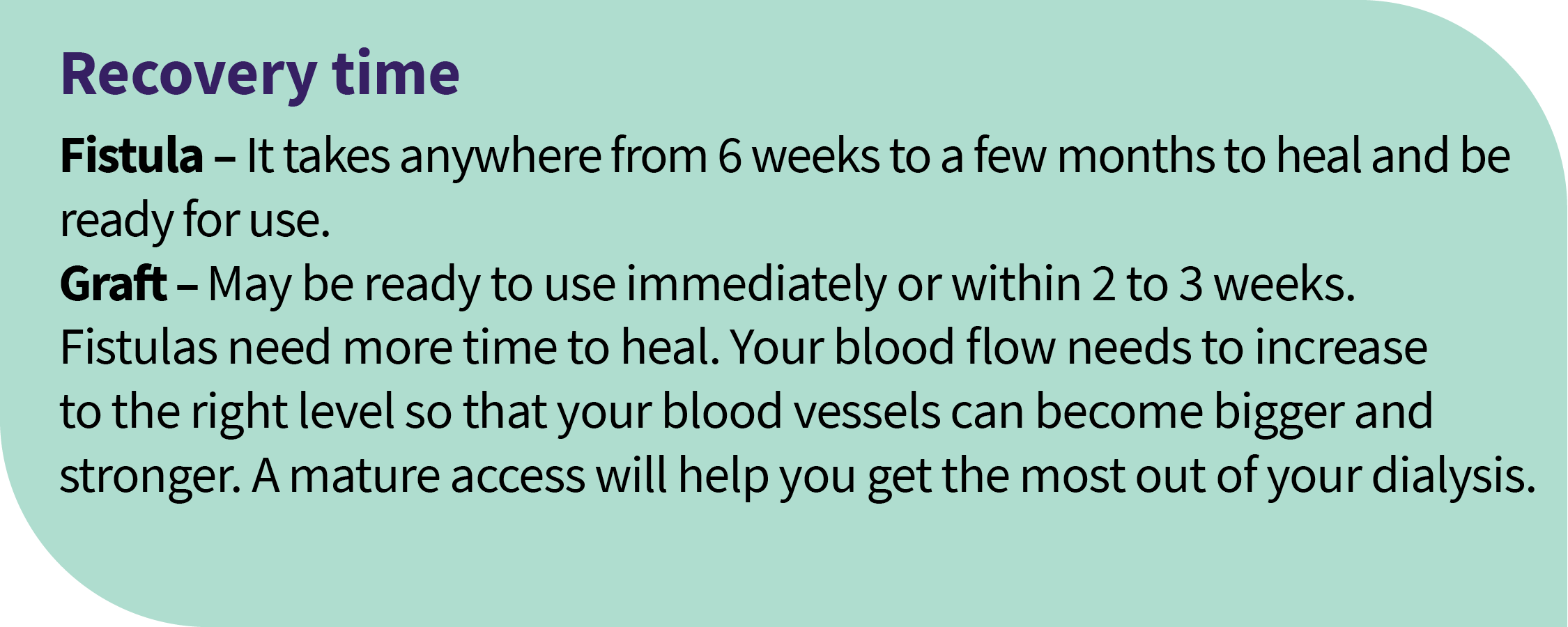Caring for Your Hemodialysis Access
Discover how to take care of your dialysis access site to keep it healthy.

Your access site is your dialysis lifeline. Keeping your fistula or graft healthy helps you get the best dialysis possible.
Having a healthy access site
Keeping your access healthy helps to make sure:
- Your treatment is successful.
- You experience the least amount of pain and discomfort.
- You can continue to feel your best.
Caring for a new access
After your access site surgery, it’s important to allow time for your fistula or graft to heal. This time allows your access to grow stronger and “mature” to be ready to use.


Ask your doctor about simple arm and hand exercises to help your fistula mature.
Practicing good hygiene
Keeping your access site clean and free from germs can help prevent infection.
- Always wash your hands before touching your access site and make sure others do too!
- Before using your access, clean your access site, arm, and hands.
Protecting your access site
Take these simple steps to protect your access:
- Wear loose clothing and jewelry on your access arm to avoid pressure.
- Learn to sleep without placing your access arm under your head or body.
- Use your other arm to carry heavy objects.
- Take your blood pressure on the arm without your access site.
- Have your blood drawn on the arm without your access site.
Keeping your veins strong
At each treatment, your care team will change the needle placement. This will help your veins stay strong and protect them from damage. It will also help you get the most out of your dialysis.

Sticking dialysis needles into your access is called cannulation. If you’re doing at-home hemodialysis, your home therapies nurse will show you how to self-cannulate (put in your own needles).
Caring for your access in an emergency
If you notice a problem, it’s important to act quickly and get it treated as soon as possible.
Infiltration
When the needle puts a hole in the fistula/graft and causes bleeding under the skin.
How to treat
Day 1: Apply a cold compress to reduce swelling (15 minutes on and 15 minutes off) for 24 hours.
Day 2: Apply moist heat to help your body absorb the clotted blood (15 minutes on and 15 minutes off) for 24 hours.
Aneurysm
When the access area expands to the point it could burst (rupture). Signs of a rupture include fast growth, tenderness, discoloration, or tight, shiny, and thin skin
How to treat
- If you think your access may be at risk of rupturing, call your doctor or nurse as soon as possible.
- If the area bursts at home, immediately apply direct pressure or a tight band called a tourniquet.
- Call 9-1-1.
Bleeding
When a fistula or graft is weak from repeated needles inserted in the same area, bleeding may occur. Significant bleeding is a rare problem. Let your care team know if you are bleeding between treatments.
How to treat
- Apply direct pressure for five minutes or until bleeding stops.
- Cover with a clean bandage once the bleeding stops.
- If the bleeding doesn’t stop, continue to hold pressure, and go to the hospital immediately or call 9-1-1.
Clotted Access
If there is less blood flow, it could mean your access is blocked by a clot. Signs of clotting include loss of vibration when you touch your access (called a thrill) or loss of the low-pitched swooshing sound (called a bruit).
How to treat
Notify your care team immediately. A clot could delay your next scheduled treatment. Left untreated, it could mean loss of your fistula or graft.
Checking your access daily
Taking good care of your access every day can help small concerns from turning into bigger problems.
- Look at your access site. Check the area around your access site for signs of redness, swelling, or leaking.
- Listen to your access. You can hear if your blood flow is strong or not. It sounds like low-pitched swooshing and is called a bruit. Your nurse or patient care technician (PCT) can show you how to listen.
- Feel the flow. Feel your access site for good blood flow. You will be able to feel a thrill, or vibration of blood flow, on a healthy access.
- Check your site for signs of tenderness, warmth, or swelling, which could be signs of infection or clotting.
Keep your access healthy
Taking good care of your access will help you stay healthy and feel your best.
- Check your access daily. Look, listen, and feel to keep a small issue from becoming a larger concern.
- Protect your access and keep your veins strong.
- Keep your access site clean and free from germs.
- Act quickly if you notice a problem and get it treated as soon as possible.
